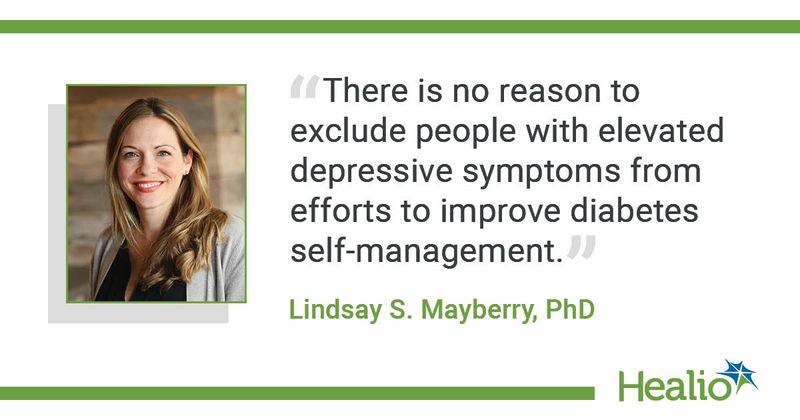Diabetes self-management support may reduce depressive symptoms in type 2 diabetes
Participation in diabetes self-management support interventions may help adults with type 2 diabetes reduce depressive symptoms, according to study findings.
In an analysis of data from a randomized controlled trial in which adults with diabetes participated in a text messaging diabetes self-management support intervention, participants with high HbA1c at baseline improved their glycemic control during the program, regardless of depressive symptoms. Even though the intervention did not address depressive symptoms, participants with low HbA1c were able to reduce their depressive symptoms at 6 months compared with baseline.

“Our study in the context of other recent studies clearly indicates there is no reason to exclude people with elevated depressive symptoms from efforts to improve diabetes self-management,” Lindsay S. Mayberry, PhD, associate professor of medicine and biomedical informatics at Vanderbilt University Medical Center, told Healio. “While they may benefit from efforts that address both diabetes self-management and depressive symptoms, targeting both does not appear necessary to see benefits.”
Mayberry and colleagues conducted a secondary analysis of data from the Rapid Education/Encouragement and Communications for Health (REACH) randomized controlled trial. In the trial, adults with type 2 diabetes prescribed daily diabetes medications from community health centers and Vanderbilt adult primary care clinics were enrolled to participate in a text message diabetes support intervention for 12 months. One-way text messages helped address participant’s barriers to diabetes medication adherence, provide information on the medications and support self-care behaviors. Two-way interactive messages supported monitoring medication adherence over time and gave encouraging feedback to the participants on their progress.
The secondary analysis focused on data collected at baseline and a 6-month follow-up when effects on HbA1c were largest. Researchers collected HbA1c values and frequency of depressive symptoms, which were assessed with the Patient Health Questionaire-8. A score of 10 or higher on the questionnaire indicated elevated depressive symptoms. A factor analysis was conducted to separate somatic-affective symptoms and cognitive-affective symptoms in the questionnaire. Findings from the secondary analysis were published in the Journal of Diabetes and Its Complications.
REACH included 506 participants (54% women; 48% white; 39% Black). Nearly were either uninsured or had public insurance, and 61% had an annual household income of less than $35,000.
At baseline, the mean score on the Patient Health Questionaire-8 was 6, with 22% of the study cohort having elevated depressive symptoms. Participants reported a higher score on somatic-affective symptoms compared with cognitive affective symptoms (3.4 vs. 2.6; P < .001). An HbA1c of 8.5% or higher was observed in 44% of participants at baseline, and those with a higher HbA1c reported having more depressive symptoms.
There was no association between the intervention and improved depressive symptoms in the overall study cohort at 6 months. However, 278 participants with an HbA1c of less than 8.5% had a reduction in overall depressive symptoms (beta = –.133; P = .007), including both cognitive-affective symptoms (beta = –.107; P = .038) and somatic-affective symptoms (beta = –.131; P = .014).
The effect of REACH on 6-month HbA1c was not modified by baseline depressive symptoms. For participants with high HbA1c, HbA1c reductions were observed, regardless of baseline depressive symptoms.
“We expected that reductions in HbA1c would be associated with reductions in depressive symptoms, particularly the physical aspects, such as fatigue and appetite changes,” Mayberry said. “In contrast to that expectation, the group that experienced the largest HbA1c reductions were different from the group experiencing depressive symptom reductions.”
Mayberry said more studies examining both physical and cognitive symptoms of depression are needed in adults with type 2 diabetes to determine how self-care behaviors might improve symptoms.
“Furthermore, we were surprised to see differential effects of the text messaging intervention on depressive symptoms for participants with high vs. low HbA1c,” Mayberry said. “Other studies have not examined this effect in different HbA1c subgroups, so more work is needed to replicate this unexpected finding to learn if it’s meaningful.”
For more information:
Lindsay S. Mayberry, PhD, can be reached at lindsay.mayberry@vumc.org.
